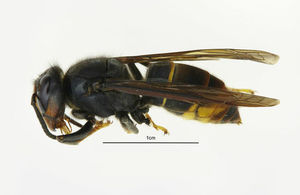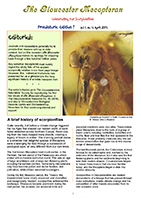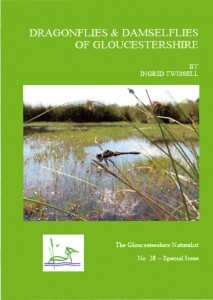
Ripple Lakes are two former sand and gravel pits in the floodplain of the Severn in south Worcestershire, very close to the Gloucestershire boundary, one on each side of the M50, on the left (east) bank. These new lakes, where extraction has only just been completed, hold fairly deep water throughout the year, in particular in late summer and early autumn when other natural wetlands in north Gloucestershire and south Worcestershire (such as Coombe Hill, Ashleworth/Hasfield Ham or Longdon Marsh) often dry out (though not in autumn 2019!). As such they represent a new wetland for the area, and are attracting water birds, both diving ducks which seek deeper water, and surface-feeding ducks and geese which can graze around the grassy edges. Clearly a topic worthy of further investigation by a recording society like Gloucestershire Naturalists’ Society: a field meeting had been scheduled in early December, but had to be postponed because the whole of the floodplain was deeply flooded. Nothing daunted, a doughty band of GNS members (with some guests from the Cheltenham Bird Club) gathered on 19 January, in bright frosty conditions with brilliant light, to investigate the birds present.
As expected, numbers and variety of diving water birds were greater than in shallower Gloucestershire sites: 35 Pochard, 65 Tufted Ducks and a Goldeneye, plus ten Great Crested Grebes. Numbers of geese and surface feeding ducks proved disappointing – just 100 Greylags and 60 Canadas (some of which may already have returned to nesting sites further north) and only 4 Wigeon and 2 Shoveler (perhaps the bigger numbers of these surface-feeding ducks were still back in shallow floodwater at Coombe Hill and Ashleworth). Another bird of interest was a Great White Egret, a still rare Mediterranean heron which has only recently begun to occur, like its smaller cousin the Little Egret, in southern England. Finally an interesting series of waders was noted: a Green Sandpiper and three Snipe would have been winter visitors. as was a most unexpected Common Sandpiper (which normally winters south of the Sahara). On the other hand two Oystercatchers on the island in the south lake were no doubt early returning birds, just arrived to assert their territorial rights on this island which holds a variety of nesting waders; spring must be just around the corner!


 The 2013 Gloucestershire Bird Report is now available. This is the 51st edition of this annual publication. Copies have already been posted to GNS members who opted to receive it. Further copies are now available to purchase for £9.50 including postage, via our
The 2013 Gloucestershire Bird Report is now available. This is the 51st edition of this annual publication. Copies have already been posted to GNS members who opted to receive it. Further copies are now available to purchase for £9.50 including postage, via our  The National Bee Unit has confirmed a sighting of the Asian hornet in the Tetbury area of Gloucestershire – the first time the hornet has been discovered in the UK. The Asian hornet is smaller than our native hornet and poses no greater risk to human health than a bee. However, they do pose a risk to honey bees. The hornet found in Tetbury is currently undergoing DNA testing at the National Bee Unit in North Yorkshire to help establish how it arrived in the UK. The hornet arrived in France in 2004 and is now common across large areas of Europe. It was discovered for the first time in Jersey and Alderney this summer. It is believed the species will not be able survive in the north of the UK due to colder winters.
The National Bee Unit has confirmed a sighting of the Asian hornet in the Tetbury area of Gloucestershire – the first time the hornet has been discovered in the UK. The Asian hornet is smaller than our native hornet and poses no greater risk to human health than a bee. However, they do pose a risk to honey bees. The hornet found in Tetbury is currently undergoing DNA testing at the National Bee Unit in North Yorkshire to help establish how it arrived in the UK. The hornet arrived in France in 2004 and is now common across large areas of Europe. It was discovered for the first time in Jersey and Alderney this summer. It is believed the species will not be able survive in the north of the UK due to colder winters. The publications page has been further extended, and now includes back issues of ‘The Gloucester Mecopteran’ – the newsletter devoted to the winged scorpionflies of Gloucestershire.
The publications page has been further extended, and now includes back issues of ‘The Gloucester Mecopteran’ – the newsletter devoted to the winged scorpionflies of Gloucestershire. Copies of ‘Dragonflies & Damselflies of Gloucestershire’ by Ingrid Twisell are now available to buy on the
Copies of ‘Dragonflies & Damselflies of Gloucestershire’ by Ingrid Twisell are now available to buy on the  Following the news that back issues of ‘GNS News’ are now available to download from this site, we have now added most back issues of ‘The Gloucestershire Naturalist’ to the online publications that are free to download or read online. Go to the
Following the news that back issues of ‘GNS News’ are now available to download from this site, we have now added most back issues of ‘The Gloucestershire Naturalist’ to the online publications that are free to download or read online. Go to the  ‘GNS News’ is the quarterly magazine published by the Gloucestershire Naturalists’ Society, containing articles on wildlife matters as well as news about the Society. Members of the Society receive a printed copy of this magazine each quarter. Back issues of the magazine are now available to
‘GNS News’ is the quarterly magazine published by the Gloucestershire Naturalists’ Society, containing articles on wildlife matters as well as news about the Society. Members of the Society receive a printed copy of this magazine each quarter. Back issues of the magazine are now available to